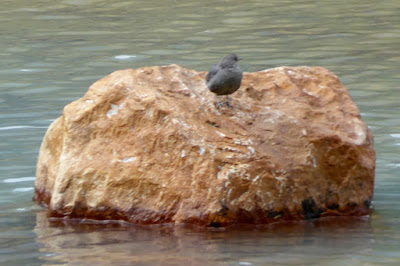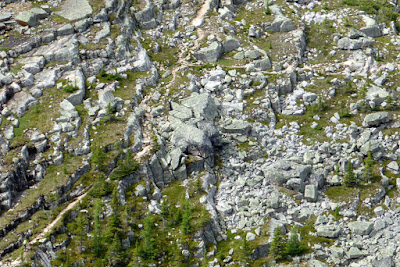The photogs loved it.
Joan and I decided to hike up to and around the Opabin Plateau today,
and leave a more alpine hike for tomorrow, when those high trails might be less snowy. This photo shows snow up at Wiwaxy Gap and the Huber Ledges,
and the snow is more widespread in the shady areas. Clouds began to form as moisture rose from the sunlit slopes.
The West Opabin trail started out through the woods.
Then it began to climb the west flank of the plateau, and Mary Lake came into view.
After traversing rocky steps and switchbacks, Joan and I neared the crest of the trail. But wait -- was that a mountain goat ahead? (Click on the image to enlarge and check the center.)
Bring up the binoculars! It sure was.
This male mountain goat was so happy to lie on the grass and chew cud in the sunshine that as long as we remained on the trail, he was unconcerned about us, even when I raised my camera. This was a great privilege he granted.
We left him to his meal, and took the short loop out to Opabin Prospect.
It's a great view out there.
Look down from the edge and get a great view of the lakes.
Joan and I continued around the Prospect, reaching the point where the trail dips down to the Cascade Lakes.
After crossing the footbridge I looked back the way we had just come.
A left turn took us to the Opabin Highline trail, which meanders deeper into the plateau along a ridge. We stopped for lunch at a viewpoint that looked back at the lakes and bluff.
This stretch of trail was deserted, but across the way we spotted hikers on the Yukness Ledges trail.
Before reaching the end of the Highline we encountered two gents who told us that there were ptarmigans on the last section of the East Opabin trail, where it climbs to its namesake lake.Joan and I reached the south shore of Hungabee Lake. (That's pronounced Hun-GAH-bee, not HUNG-a-bee.) Opabin Lake is beyond the moraine that rises from the far shore, and can be reached from either side.
We encountered a pair of guys navigating, barely, by a map on their phone that had no topographic lines or lake names. They asked if this was Hungabee, and we assured them it was.
Ascending the East Opabin trail, we indeed encountered ptarmigans. Seven of them, in the dry creekbed just left of the footpath. They were fluffed up against the cold,
and changing into their winter plumage.
Some would venture out of the creekbed from time to time,
and one, seemingly cast out from the group, gave us quite a stare. Was it curious, or on alert?
We, and others, approached Opabin Lake.
The water levels were low here too, similar to our visit to Lake McArthur.
To make a loop Joan and I crossed to the west side of the moraine, where another trail ascends/descends, and looked down on Hungabee Lake. The West Opabin trail is visible on the left.
We noticed a group that was traveling "cross-country" towards the All Souls trail, rather than taking the West Opabin down to the far end of the plateau, where the two intersect. Technically this may be the shorter distance but I don't think they could have saved much time.
Joan and I returned to our cabin, and I caught this sunset photo on our return from dinner.
What a day, with ptarmigans and a mountain goat closeup! Tomorrow, our last day at Lake O'Hara.




















































